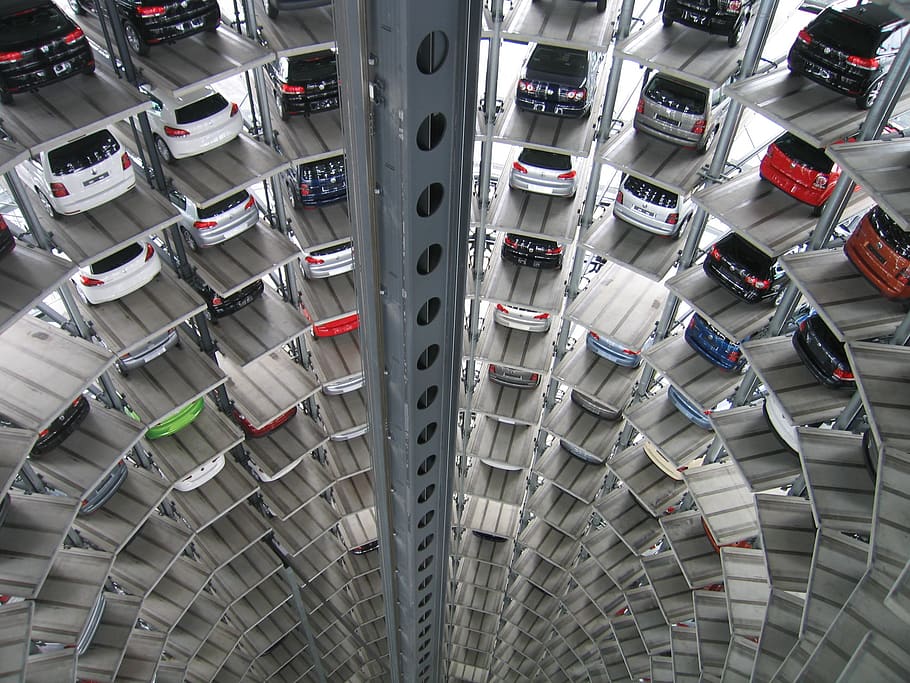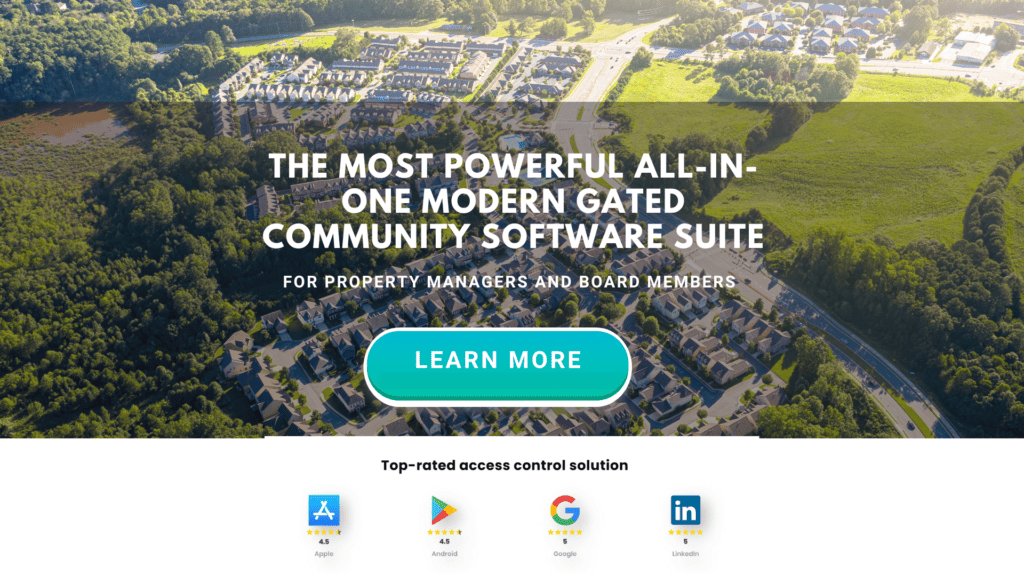Imagine heading to a sold-out concert, and your ticket doesn’t just secure your seat—it reserves a parking spot for your car, too. As you approach the venue, the gates recognize your license plate and open automatically. LED arrows then guide you to your designated parking space, complete with an EV charger ready and waiting.
It sounds futuristic, doesn’t it? But this isn’t some sci-fi fantasy—it’s happening now.
Thanks to the integration of License Plate Recognition (LPR) with smart gates and advanced parking systems, the future of access control is already here. This technology isn’t just reserved for venues with deep pockets. It’s available now for any property manager who wants to deliver convenience and innovation at every turn.
IN THIS ARTICLE
- Why Modern Access Control Needs to Evolve
- LPR: The New Standard in Credentialed Access
- Smart Gates: Beyond Open and Close
- Parking Systems: The Backbone of Access Flow
- Integrating LPR with Smart Gates and Parking Systems
- Benefits of a Unified System for Gated Communities and Clubs
- The Role of CCTV in the Future of Access Control
- Trends in Access Control Technology
- Final Thoughts: Setting the Standard for Tomorrow
Why Modern Access Control Needs to Evolve
The old-school approach to access control, such as physical keys, manual logbooks, and basic cameras, was used to get the job done. Keys allowed entry, logbooks tracked visitors (assuming someone remembered to log them), and CCTV cameras captured footage to review after something happened.
But today’s world is faster and more connected than ever before, and it’s time for access control and parking to catch up.
Modern gated communities, commercial properties, and clubs need more than just a way to open doors or review grainy footage. As properties expand and visitor traffic grows, scalability becomes a real challenge. Managing access for dozens or even hundreds of vehicles and pedestrians daily demands speed and efficiency.
And while static CCTV is great for reviewing incidents after the fact, it can’t fill the need for real-time security.
Outdated systems also lack the ability to deliver useful, data-driven insights. Today’s environments call for advanced solutions like License Plate Recognition (LPR) and smart gate systems that elevate gate access control, effortlessly handle growth, and provide actionable data.
In comparison, traditional methods feel like relics of a simpler (and slower) time.
LPR: The New Standard in Credentialed Access
License Plate Recognition (LPR) technology is reshaping access control by transforming vehicles into virtual credentials. With the help of cameras and intelligent software, LPR scans license plates compares them to a pre-approved database, and either grants or denies entry, all in just seconds. No need for physical keys, keycards, or gate codes; it’s a straightforward, hands-off solution.
Picture a busy gated community during rush hour: instead of residents scrambling for key fobs or waiting for a manual gate to open, LPR takes care of it automatically. The system recognizes each vehicle, the gate opens smoothly, and traffic flows without allowing tailgaters to slip through behind them.
How LPR has Modernized Access Control:
- Speed: Granting entry takes seconds, cutting down wait times.
- Accuracy: Reduces errors by automating credential checks.
- Data Integration: Tracks entries and exits in real-time for better oversight.
- Convenience: Offers a seamless, touchless experience for residents and guests.
It’s no surprise that LPR is quickly becoming the go-to standard for efficient, modern access control systems.
Smart Gates: Beyond Open and Close
Smart gates are transforming how properties manage access, offering capabilities far beyond the traditional open-and-close mechanism.
These advanced gates are equipped with IoT sensors, smart software, and integration with tools like LPR and parking systems. They can even be controlled remotely, giving property managers unmatched convenience and flexibility.
Unlike traditional gates that depend on manual input or simple automation, smart gates respond dynamically using automated triggers and real-time data.
Need to handle high traffic during peak hours? Or stop an unauthorized vehicle from entering? These gates have it covered—no extra intervention required.
How Smart Gates Works with LPR:
- Remote Management: Control gates from anywhere, cutting down the need for on-site staff.
- Seamless Integration: Work effortlessly with LPR and parking systems for a smoother access experience.
- Data Logging: Track real-time entries and exits to boost security and provide actionable insights.
- Scalability: Perfect for growing communities and busy properties with heavy traffic flow.
With smart gates, access control becomes efficient, adaptable, and smarter than ever.
Parking Systems: The Backbone of Access Flow
Parking systems are what brings everything together to create smooth access control, and they do much more than just offer places to park. They manage the flow of vehicles efficiently, minimizing delays and reducing confusion, which makes them a key part of a property’s overall access management strategy.
When paired with technologies like LPR and smart gates, parking systems become even more powerful. These integrations automate vehicle tracking, instantly recognize authorized vehicles, and eliminate the need for manual checks or outdated paper tickets.
During peak times, they keep traffic moving, reduce bottlenecks, and maximize the use of available spaces.
How LPR and Smart Gates Enhance Parking Systems:
- Automatic Vehicle Tracking: Effortlessly identifies and logs vehicles in real-time.
- Reduced Congestion: Speeds up the entry and exit process during busy hours.
- Optimized Space Use: Guides drivers to the nearest available spots for better efficiency.
Take a commercial property hosting a big conference, for instance. With these advanced systems in place, they can handle the surge in visitors with ease, ensuring a streamlined experience for everyone involved.
Integrating LPR with Smart Gates and Parking Systems

Merging License Plate Recognition (LPR) technology with smart gates and parking systems means creating a seamless, self-contained, efficient system. The heart of this integration lies in smooth communication between all the pieces, achieved through standardized protocols or APIs.
For example, the LPR system needs to sync with smart gate controllers and parking software to share data in real time. This coordination powers automated actions, like opening gates for authorized vehicles and instantly updating parking availability in the system.
Key Elements of a Successful Integration:
- Centralized Management: A single platform that brings together data from LPR, gates, and parking systems, making it easy to monitor and manage everything from one dashboard.
- Cloud Connectivity: Scalable, cloud-based solutions like Proptia allow remote access and securely store logs and analytics.
- Data Security: Advanced encryption and robust firewalls protect sensitive information like license plate records and entry logs, ensuring compliance with privacy regulations.
Challenges and How to Tackle Them:
- Hardware Compatibility: Older systems might need upgrades to work with IoT-enabled devices and high-resolution LPR cameras.
- Network Reliability: A stable, high-speed local network and internet connection is crucial for uninterrupted communication between systems.
- Staff Training: Teams need to be equipped with the know-how to use and troubleshoot the new integrated setup.
Address these hurdles early on, and communities, clubs, and commercial properties can create a unified, high-performing access control system. With LPR, smart gates, and parking technologies working in harmony, managing access becomes easier, smarter, and more secure.
Benefits of a Unified System for Gated Communities and Clubs
Bringing together License Plate Recognition (LPR), smart gates, and parking technologies into one cohesive system offers gated communities and clubs a host of benefits. These integrated solutions simplify guest management, strengthen security, and lighten the workload for property managers.
Key Advantages:
- Effortless Guest Management: With LPR, pre-approved visitors can enter smoothly without manual checks or long waits. For last-minute guests, property managers can remotely grant access through a centralized system.
- Stronger Security: Integrated systems provide time-stamped logs of every entry and exit, helping to quickly spot any unusual activity or unauthorized vehicles.
- Time and Cost Savings: Automation minimizes the need for on-site staff, cutting labor costs and freeing property managers to focus on more important tasks.
What a Unified Access Control and Parking System Could Look Like
Let’s look at the example of a gated neighborhood hosting a big community event. Guests who RSVP’d in advance are preloaded into the system, so as they arrive, LPR-enabled gates recognize their vehicles and grant them immediate access.
The parking system then directs cars to the nearest available spots, while security staff monitors entries and exits in real time from a centralized dashboard. Everything runs smoothly, with no backups and no confusion.
This unified approach creates streamlined operations and means a better experience for residents, visitors, and managers alike.
The Role of CCTV in the Future of Access Control
Modern CCTV systems play an important supporting role in the future of access control, complementing LPR and smart gates by adding a visual layer of security. While LPR handles vehicle identification and smart gates manage automated access, CCTV provides real-time video monitoring and recording to ensure comprehensive coverage.
One of CCTV’s primary advantages is its ability to serve as a backup for LPR systems. For instance, if a license plate is unreadable due to dirt or damage, CCTV footage can verify the vehicle’s legitimacy.
Additionally, cameras provide context for alerts, such as detecting unauthorized access attempts or vehicles tailgating through gates.
An Example of CCTV and LPR in Action:
A gated club experiences a suspicious entry late at night. The LPR system flags an unregistered license plate, and CCTV captures footage of the vehicle, revealing identifying details and the driver’s behavior.
Security personnel can act immediately, verifying the alert and ensuring the property remains secure.
Trends in Access Control Technology
Access control is on the brink of a transformation fueled by smarter, more efficient innovations. AI-powered LPR systems are stepping up their game by learning from real-world usage patterns, making vehicle identification faster and more accurate.
A predictive parking system could guide drivers to open spots even before they arrive, keeping traffic flowing and stress levels low. Advanced analytics will also give property managers powerful tools to spot trends and implement proactive security measures.
Sustainability is also becoming a driving force. Energy-efficient gates and solar-powered systems are no longer niche—they’re increasingly accessible and practical. These green solutions not only reduce environmental impact but also cut operational costs, making them a win-win for modern properties.
As technology becomes more affordable and integration easier, gated communities and commercial properties are poised to adopt these advancements widely. The result is a future where access control is not just smarter and safer but also eco-friendly and effortlessly seamless.
Final Thoughts: Setting the Standard for Tomorrow
Integrating LPR with smart gates and parking systems is no longer a vision of the future—it’s the defining standard for modern access control. These technologies improve security, simplify management, and enhance the overall experience for residents and visitors in gated communities, commercial buildings, and clubs.
With advancements continuing, these systems are setting new standards for safety, sustainability, and operational efficiency.
If improving your property’s access control is a priority, Proptia can help. Our solutions are designed to strengthen security, streamline processes, and create a more efficient and user-friendly environment for your community or business.


